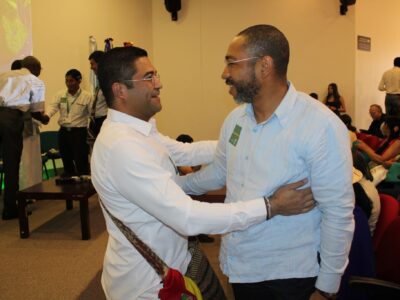
In April, a number of ACDI/VOCA staff members had the great pleasure of participating in the 2019 Market System Symposium in Cape Town. An important thought leader in systems thinking, Marcus Jenal, blogged about his experience at the symposium. In his post, he raised questions about the role of behavior change in market systems development. In asking “should we fix wrong behavior?”, he critiques the idea of embracing behavior change as an area of focus in market systems development programming.
Jenal’s blog sparked conversation among ACDI/VOCA colleagues–including market systems and Social and Behavior Change practitioners–about the relationship between behavior change and market systems. The following conversation, presented without major edits, ensued. We hope it prompts your own internal dialogue and sparks further healthy debate.
Cheryl Turner, Managing Director, Technical Learning and Application (TLA) Unit:
Hi all – I am interested in the discussion in Jenal’s blog about behavior change for private-sector actors, and the assumptions of Western contexts.
Dun Grover, Director of Monitoring, Evaluation & Learning for the USAID Honduras Transforming Market Systems (TMS) Activity:
My take on Marcus’s blog is who is the “agent” that modifies the behavior? When development actors design and push behavior changes, the issues Marcus points out are real problems. However, if the market actor is the principal agent that explores a new set of behaviors, and the development organization facilitates this learning process to see what works in a context, then this is a more appropriate role. It’s a development as freedom perspective. Development actors may supply information to inform rational choices, bridge networks to open up new choices, or even work on high-level institutional change with the potential to change the landscape in which choices are made.
On the other hand, the reality is that behaviors are often effective ways to orient teams around a market facilitation strategy. Results chains, AAER frameworks, and systems maps are mostly developed based on preconceived market behaviors. Arguably, these are much better ways to orient teams than an approach based on a “lack of,” e.g., farmers lack seeds, therefore, let’s give or subsidize seeds. A behavior-oriented strategy would say, let’s focus on desired progressive sales strategies or tactics that are characteristic behaviors you’d like to see on the part of input dealers. Behaviors are also measurable, which many things in systems are not, so when we achieve success we can quantify it.
Sarah Sahlaney, Social and Behavior Change (SBC) Director:
Weighing in on this! I like Dun’s point that, as we do more market systems work, behavior change will become more and more important, both as a way of designing activities and as a way of measuring systems change.
But, I want to clarify something about how you identify behaviors in the first place. Good SBC practitioners will work WITH an actor to identify a set of behaviors that are ideal. When USAID talks about avoiding “didactic messaging and behavior change,” this is exactly what they’re talking about–they’re saying that any decent SBC program isn’t going to just move in and start promoting behaviors without a co-development process. Instead, you do a lot of research and work WITH the actors to identify some ideal behaviors. The process should be participatory from the start. Part of this process is also predicated on a lot of science that suggests that actors are more likely to adopt a behavior if they themselves have identified it as a goal. We are going to do it with the USAID Food for Peace Victory Against Malnutrition Plus (ViMPlus) project. So, the idea isn’t (or shouldn’t be) to tell market actors that they’re practicing “bad behaviors” and then suggest a set of “good behaviors.”
The blog also raises the argument that directly targeting people’s behavior is morally problematic. This has been widely debated by behavioral scientists and policy makers (google libertarian paternalism). While you can’t dismiss power dynamics, I don’t think it’s a huge moral quandary as long as you’re identifying behaviors with a community, not for them.
Dun:
Sarah, your point reinforces why diverse perspectives are critical to making sense of market systems, as it is really a convergence of disciplines as part of a systems perspective. There’s also a distinction that we shouldn’t overlook–the argument that the ideal behaviors in market systems for a given context is often unknowable at a point in time–either by the market actor or anyone else for that matter. In this case, the “identification” is not linear, but is a non-linear process of real-time retrospection, iteration, and adaption that is critical to learn by doing and to discover what “ideal” behaviors fit the current context. This is complicated by the evolutionary aspect of market systems, and often intent behind MSD, in which the context transforms what behaviors are made by evolving political, social or market structures. Operating under uncertainty requires a different tact or approach that is really at the core of the behaviors in the market system challenge. However, maybe this is already a core tenant of SBC, and non-SBC folks just need to learn about it.
Sarah:
The Designing for Behavior Change (DBC) process has guidance on behavior identification; it’s a core tenant of SBC. But we in the SBC community don’t always talk as much about the complexity of identifying these behaviors in a market systems approach.
Dun:
In terms of practical implementation, there is a huge challenge to put this theory into practice. For example, how do you set a baseline on a behavior if you don’t know which behaviors matter or which are right? Is it a good idea to structure grant milestones around a partner behavior change (what if that change ends up being less desirable, even if both you and the partner thought it was good at first)? How do you create a clear team orientation for change in which the set of desired behaviors are unknown, or even unknowable at the beginning? These are real considerations when you’re working in a really complex market system.
Sarah:
This is spot on. Identifying these behaviors is hard, especially when systems are so complex. The SBC community, especially the CORE Group SBC Working group, has had some events (here and here) at which we’ve discussed constructivism and how it informs our behavior identification and thinking, as well as how, because these behaviors are constructed, they also change based on our understanding and on the shifting context. So, there is some thinking that you need to constantly revisit the behaviors that you’ve identified with your partners. This is especially true when we’re talking about market systems behaviors, rather than, say, health behaviors.
Cheryl:
Dun’s comments remind me of some of the discussions we started with Erin Markel from MarketShare at the end of ACDI/VOCA’s 2017 SBC and Market Systems Virtual conference about complex systems and using SBC theory and practice to track changes.
I also think it’s important to distinguish between behavioral economics, which is mostly about the disconnect between what people say they will do and what they actually do in an economic sense, and social and behavior change, which is a more participatory approach to development, as Sarah notes below. Behavioral economics (as a subset of economics) does in fact have a specific perspective about what people should do (so that economic theories work). While both approaches can be useful in our work, and in understanding why people do what they do, they are not the same.
Sarah:
And SBC and behavior change are obviously tied, but not always the same; SBC is a practice with a clear body of research and approaches, while behavior change itself can be interpreted as a much more nebulous term.
Sergio Rivas, Chief of Party, Honduras TMS:
Jumping in – I love the conversation! I read Dun’s point more as nobody should even try to identify what people should do. Market actors integrate social, political, and economic variables in their thinking without even noticing. We as development actors should work together with market actors to allow them to experiment, based on their own pain points, facilitate an interpretation of their findings and conclusions, and support the scaling of concrete, meaningful solutions that others in the system will hopefully imitate and replicate. This is a humbler position than targeting an entire complex behavior for change with limited funding and time and/or attempting to parcel out where social behavior starts and economic behavior ends.
Bob Fries, Executive Vice President, TLA:
Wow. Just getting to this dialogue now. I’m sharing a schematic presented by Marcus at a Symposium workshop on decision making: the Cynefin framework. This helps us to look at complex systems with some nuance. Even within complex systems, not all elements or issues are complex. In some of the systems we are working in, and the projects we are working on, it’s obvious where best practice can be applied. Other elements are complicated, where analysis and good practice are helpful. Others are complex (and I would expect that the behavior change elements often fall into this category), and probing and learning are critical. How we break elements and issues into these distinct categories, and develop layered courses of action, will be critical to our work in this space.
Dun:
To add to Sergio’s point, one of the more foundational elements that came across strongly for me from Market Systems Symposium–and I can say is perhaps the biggest leap for a lot of us indoctrinated first in the value chain (and even M4P) approach–is getting away from a prescriptive orientation to a retrospective one. I’m still struggling with the practical implications of this.
The emphasis on planning and strategy is really deemphasized in market systems. When you intervene in markets, they are so complex, the grand plans and complicated strategies you try to develop are inevitably wrong. More importantly, when you develop your monitoring, grant, and implementation systems around such plans, you tend to ignore the weaker signals in the market that should tell you they’re wrong and it’s time to change. Instead, you get stuck in programmatic inertia, that it is really hard to change. Alternatives discussed a lot at the Symposium, which Bob also flagged in his comments, are “probing” and “sensemaking.”
This shift, or rather re-balancing, from a heavy orientation on planning and strategy to an orientation based on doing, then learning and adapting, essentially where you plan and strategize as you go, is hard and complex to put in practice. Frankly, I don’t think we’ve fully figured out how to do this yet practically (versus conceptually), though there are interesting activities making headway here.
Dan White, Director of Agriculture, TLA:
I finally had a chance to read this thread and Marcus’s original blog post this morning. Lots of thoughts, but the big one is that it highlights a core contradiction in our work that is rarely said out loud.
On the one hand, our projects are funded to achieve very clear policy objectives, which almost always include explicit behavior change on the part of our beneficiaries, often on the most important aspects of their lives. Only within those parameters can we pursue participatory approaches, which is a huge reason we consistently regress toward prescriptive action plans and paternalistic strategies.
At the same time, we in the development space interface with such a wide variety of actors; few others have this access or interest in different perspectives on a single economy and society, particularly in countries with weak democracies and stark inequality. Anyone in that position who is paying attention and asking questions can’t help but see the complexity and emergence Marcus describes, and the need for humility in designing interventions, as Sergio and Dun suggest.
The challenge is to find openings for the kind of open-ended iteration and radical participatory experimentation that we all see as more likely to deliver the most durable positive change. And to be able to get buy-in from donors on approaches that help people, economies, and societies weather the large-scale challenges they face and adapt to without as much behavioral prescription.
————
So where does this leave us? Well, to be honest–as you can see from the exchanges above–we have a diversity of perspectives on the issue, drawing on several diverse technical disciplines and experiences. And that’s a good thing, in fact, because in the process, we questioned things that deserve poking; and were challenged.
At ACDI/VOCA, there does seem to be a shared perspective that behavior change has an important role to play in our market systems development practice, and there is an incredibly rich body of work from the behavior change field to learn from and build on. But there is also a shared perspective that systems thinking–and the real-life laboratories that our more progressive market systems development programs in the field provide can reveal a lot about:
- the way we go about prioritizing certain behaviors for change (e.g., highly participatory, stakeholder-led, iterated through probing and sense-making activities, inclusive of a diverse range of possibilities for positive change)
- the humility with which go about the entire process
- management and M&E processes in place to re-configure as we learn
- and the pathways through which we seek to nurture change (e.g., through more systemic shifts in incentives, structures, and norms)
What do you think? How does this play out in your programs, especially those of you working on market development programs? Let us know in the comments.
—Anna Garloch, Director Inclusive Market Systems, TLA
Comments








